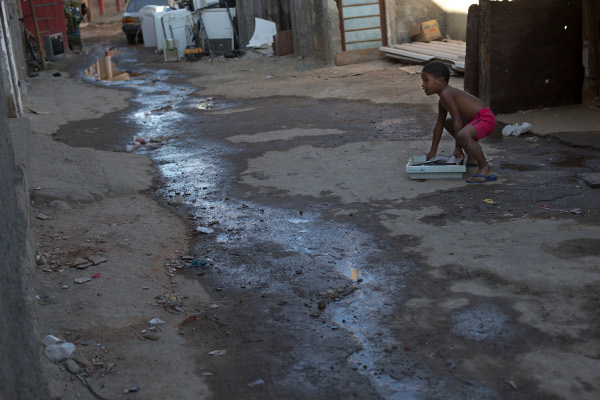Zika Virus and Global Inequality:
A Deadly Combination
February 22, 2016 | Revolution Newspaper | revcom.us
The World Health Organization (WHO) has declared a global public health emergency due to what they’ve described as the “explosive” spread of the Zika virus. Over the last year, the virus has been detected in 23 countries in the Americas. As many as four million people could be infected with the virus throughout the hemisphere this year.

The Zika virus is mainly infecting and spreading rapidly among poor people in oppressed countries because of the conditions of life imposed and enforced by global capitalism-imperialism. Above: A boy plays next to sewage water slowly running through the Mandela slum in Rio de Janeiro, Brazil, August 2015. AP photo
There is a correlation and possible link between the Zika virus and thousands of birth defects in Latin America. News of the rapid spread of the Zika virus has created a growing panic in Brazil because there has, at the same time, been a dramatic increase in the number of infants born with microcephaly in the same areas of Brazil where the virus has been concentrated.
Microcephaly is a birth defect that causes babies to be born with abnormally small heads, and a wide range of resulting symptoms: developmental delays (slow to speak, sit, stand or walk); problems learning or functioning in daily life; seizures; problems seeing or hearing; problems eating and swallowing. Brazil has estimated there are 1.5 million people who have been infected with Zika virus.
What Is Zika Virus?
A virus is a small infectious agent that cannot reproduce by itself, but hijacks a human cell to make a copy of itself. The Zika virus was first discovered in 1947 in Uganda in Rhesus monkeys and since has been found in people. It is related to the viruses that cause dengue fever and yellow fever, both of which are transmitted by the same mosquito, called Aedes aegypti. The spread of mosquito-borne diseases like the Zika virus may have increased because of rising temperatures due to global warming. Higher temperatures increase the rate at which mosquitoes reproduce and where they can survive. Also, deforestation, which is going on at a massive rate in Brazil, destroys the habitat of animals and insects that eat mosquitoes.
The Zika virus has symptoms that are considered relatively mild compared to dengue and yellow fever, which are painful, debilitating mosquito-borne disease affecting hundreds of millions of people in tropical areas of the world. Eighty percent of the people who are infected with the Zika virus show no symptoms; others have relatively minor symptoms—fever, rash, joint pain, red eyes. But the reason Zika has now been declared a global health emergency of such great concern is because of the possible link between the virus and the rise in incidences of microcephaly and there is no cure or vaccine, and it is unlikely that a vaccine will be produced for several years. In the face of this crisis, instead of making birth control and abortion more accessible for women, authorities are just telling the women living in areas where they could get the Zika virus that they should just “not get pregnant” or to “delay getting pregnant.”
Zika virus may also be linked to Guillan-Barre syndrome (GBS). This is a rare disorder where a person’s own immune system attacks the nerve cells, causing muscle weakness and sometimes paralysis. While most people fully recover from GBS, some people have permanent damage, and in rare cases, people have died. Like microcephaly, it is not yet known for certain that Zika virus causes GBS, but there appears to be an increased number of people affected with it in Brazil and it has now been reported that Colombia has seen a sharp increase in the number of patients diagnosed with GBS.
The Violence of the Church and the State Caused by Outlawing Abortion

Break ALL the Chains!
Bob Avakian on the Emancipation of Women and the Communist Revolution
The spread of the Zika virus and the correlation of it with a dramatic increase in microcephaly shines a huge spotlight on the horrendous situation for women throughout the world, including women in Brazil and other Latin American countries, where abortion is highly restricted or completely banned.
Microcephaly is difficult to diagnose in a developing fetus and most cases can only be diagnosed through an ultrasound—and not until about 24 weeks into the pregnancy. And since most pregnant women who may be infected with Zika virus might not even have symptoms, this may delay a diagnosis until the beginning of the third trimester of pregnancy. Women who find out that their fetuses are microcephalic then face a situation where they are unable to get abortions because they are banned outright or because late term abortions are outlawed.
As International Planned Parenthood has pointed out: “Poor women and women in rural areas are more susceptible to infection and less likely to have access to sexuality education and contraception.” In fact, 200,000 women in Brazil are hospitalized every year from complications of illegal abortions. With the spread of the Zika virus, many more women will perform unsafe, illegal abortions and more will die.
Seven of the 34 countries in the region have a complete ban on abortion, 23 have severe limits and only four allow abortion for any reason. Because of the lack of access to birth control, over half of pregnancies are unintended. It is estimated that 95 percent of abortions carried out in Central and South America are illegal and unsafe. So millions of women in these countries are now being forced to choose between risking harm or death by resorting to “back-alley” abortions, or giving birth to potentially microcephalic babies.
Abortion in Brazil is illegal except in cases of rape, or danger to the life of the woman, or in a case where it can be shown that part of the brain of the fetus is missing. At the same time, one in five women in Brazil will have at least one abortion by the time she reaches age 40; which means five million women a year in Brazil could face jail for three years for committing the “crime” of having an abortion. In El Salvador, hundreds of women have been jailed for “murder” for having an abortion or even a miscarriage!
With no access to birth control, or ability to travel to countries where abortion is legal, poor women in all of these countries have it the worst. There has been a great deal of attention drawn to the Catholic Church and the horrific role it is playing in telling women that abortion—and even birth control—are absolutely forbidden by the church. In fact, while Pope Francis was traveling in Mexico recently, he said contraception may be acceptable in fighting the Zika virus but that abortion is a “crime, an absolute evil.”
The Vatican issued a statement that said, “Given the potential implications for pregnancy and for the spread of the disease, it is clear that part of an effective response should involve the promotion of abstinence” and that basically, women should carry to term a pregnancy where there is a diagnosis of microcephaly and then care for that child. This is right in line with the whole patriarchal, anti-women role of the pope and the Catholic Church—which has condemned millions of women to forced motherhood or death for lack of birth control and safe and legal abortions; forced women to carry a burden of guilt if they work outside the home, want to control their own reproduction, decide not to have children and struggle to be respected as equal human beings and to fully participate in society.
The Zika Virus Has Natural Causes, but the Global Capitalist System Has Made It Much Worse
Zika virus is mainly infecting and spreading rapidly among poor people in oppressed countries because of the conditions of life imposed and enforced by global capitalism-imperialism. The epicenter of the outbreak in Brazil is the “favelas” (shantytowns) of the northeast. Brazil has the largest economy in South America; it also has the largest concentration of poverty, where the top one percent make more than the bottom 50 percent combined.
In these poor areas, people don’t have air conditioning or screens, rubbish collection is sporadic, and people don’t have running water so they’re forced to store their own. The Aedes aegypti mosquito can breed in a thimbleful of water and most are breeding inside people’s homes where they store water. In a recent opinion piece in the New York Times, Debora Diniz, founder of Anis–Institute of Bioethics, Human Rights and Gender and a law professor at the University of Brasilia—wrote:
Lost in the panic about Zika is an important fact: The epidemic mirrors the social inequality of Brazilian society. It is concentrated among young, poor, black and brown women, a vast majority of them living in the country’s least-developed regions. The women at greatest risk of contracting Zika live in places where the mosquito is part of their everyday lives, where mosquito-borne diseases like dengue and chikungunya were already endemic. They live in substandard, crowded housing in neighborhoods where stagnant water, the breeding ground for disease-carrying mosquitoes, is everywhere. These women can’t avoid bites: They need to be outdoors from dawn until dusk to work, shop and take care of their children. And they are the same women who have the least access to sexual and reproductive health care.
In contrast, Dr. Celine Gounder MD, an infectious disease specialist wrote in the Guardian why Zika is unlikely to become an epidemic in the United States:
...A higher standard of living, including better home construction and air-conditioning insulate Americans against mosquitoes. Our water and sanitation systems reduce our exposure to standing water, where mosquitoes like to breed, and we have robust mosquito control programs to keep local populations in check. While we could see clusters of Zika transmission in pockets of extreme poverty, it is highly unlikely to become a widespread problem as in Brazil.
Intolerable... and UNNECESSARY Suffering
What makes all of this so intolerable is that it’s unnecessary. The capitalist-imperialist economic system dominating the whole world is driven by the competitive accumulation of profit—a dynamic that leads to and takes place through an enormous chasm between a handful of developed imperialist countries and the bulk of humanity living in countries exploited and shackled by imperialism. The horrible spread of the Zika virus in Brazil underscores how there is great disparity and acute polarization in the world, where tremendous wealth and power are concentrated in the hands of a small number of people, and in a handful of countries, while in most parts of the world, and in the world as a whole, the great majority struggle, often unsuccessfully, even to secure the basic necessities of life. But the world actually does NOT have to be this way. Revolution to bring about a whole different economic and political system—on the road to bringing about the emancipation of all humanity—is not only necessary but possible.
Volunteers Needed... for revcom.us and Revolution
If you like this article, subscribe, donate to and sustain Revolution newspaper.







